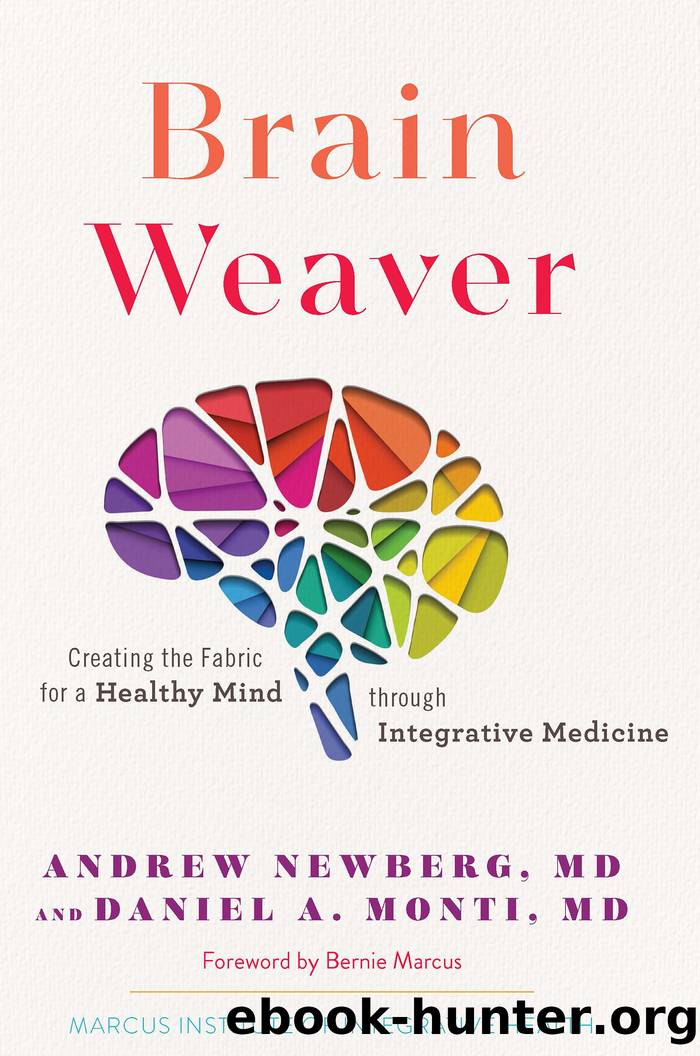Brain Weaver, Volume 1 by Andrew Newberg

Author:Andrew Newberg
Language: eng
Format: epub
Publisher: Kales Press
Published: 2021-03-28T00:00:00+00:00
WEAVING TOGETHER A BETTER BRAIN THROUGH MUSIC
Just like visual art, auditory artâmusicâis a natural complement to the way your brain works. Research studies looking at neurological electrical activity have revealed that the brain basically works through rhythms. Rhythmic electrical activity is part of how the brain thinks, feels, sleeps, and wakes. Since the brain is awash in rhythms, it appears that the rhythm of sounds taps into its fundamental functions. For example, there are sounds all around us that are essential for us to understand and identify, such as an ambulance siren or a childâs laughter. And the brain is particularly adept at being able to distinguish the differences between them, as in the case of a human voice and the differences between calming language and excited language. We hear the distinctions in a tone of voice that have to do with the intensity and the repeatability of the rhythm that the voice and language make.
Your brain has a number of areas involved in processing soundsâin particular, the thalamus, temporal lobe, and auditory cortex. Functional magnetic resonance imaging studies have also documented the pathways involved in our sense of hearing and the impact that different sounds have on brain functions. Slow, rhythmic sounds such as chanting and the sound of the ocean can be relaxing, help your brain achieve a calm state, and even reduce anxiety and stress. But if youâre getting ready to do something active like play football, rapid rhythmic sounds such as rock music and rapid drumming can activate your brain.
All kinds of research have observed the effects of music on the brain. For instance, in a hospital operating room, music can help put not only the patient in a calmer state but the surgical team as well.4 In fact, calm music has been shown to improve surgical outcomes because of the beneficial effect on the brains of both patients and surgeons.
In order to create your own optimal brain program, it is important to recognize what types of music and auditory rhythms you personally enjoy. This is helpful to know especially when it is time to relax (e.g., before going to bed ) and when it is good to be aroused (e.g., when youâre driving ). Different music throughout your day, and even throughout your life, can be essential for guiding your brain through its everyday functions.
While music certainly can help alter your emotional state, it is less clear how much listening to music can improve cognition. A number of years ago, several investigators explored the Mozart effect, particularly in children. In the end, it does not appear that listening to Mozart by itself necessarily makes you smarter, but it probably does make you more relaxed. We have mentioned our earlier study of the Kirtan Kriya meditation practice (please see pages 65â66). Interestingly, the specific one we worked with is a singing meditation, so when we did our study, we compared the meditators to a group of people listening to Mozart concertos.5 Both groups had improvements in their overall stress and anxiety levels, but the brain areas affected were markedly different.
Download
This site does not store any files on its server. We only index and link to content provided by other sites. Please contact the content providers to delete copyright contents if any and email us, we'll remove relevant links or contents immediately.
| Administration & Medicine Economics | Allied Health Professions |
| Basic Sciences | Dentistry |
| History | Medical Informatics |
| Medicine | Nursing |
| Pharmacology | Psychology |
| Research | Veterinary Medicine |
A History of the Human Brain by Bret Stetka(492)
The Spike by Mark Humphries;(465)
Basic Exercise Physiology by Moran S. Saghiv & Michael S. Sagiv(462)
The Plague Cycle by Charles Kenny(445)
The Whole-Body Microbiome by Brett Finlay & Jessica Finlay(422)
Virus Mania by Torsten Engelbrecht; Köhnlein Claus(398)
Reviews of Physiology, Biochemistry and Pharmacology by Unknown(380)
The Genetic Lottery by Kathryn Paige Harden(380)
Your Brain on Exercise by Gary L. Wenk(344)
Lymph & Longevity by Gerald Lemole(338)
Biophysics of Membrane Proteins by Unknown(327)
Soft-Wired: How the New Science of Brain Plasticity Can Change Your Life by Dr. Michael Merzenich Phd(296)
Fixing My Gaze by Susan R. Barry; Oliver Sacks(287)
Anatomy of the human body: Anatomy body part by Anik Ahmed(287)
Corona, False Alarm?: Facts and Figures by Karina Reiss && Sucharit Bhakdi(284)
Netter's Clinical Anatomy E-Book by John T. Hansen(280)
Structural Immunology by Unknown(255)
Essentials of Pathophysiology by Tommie L. Norris(244)
Brain Weaver, Volume 1 by Andrew Newberg(222)
